

Learn Data Analysis - Free Curriculum. Introduction The Data Analysis learning path provides a short but intensive introduction to the field of data analysis.
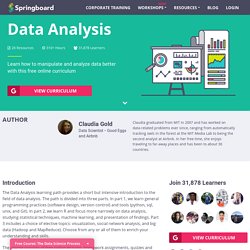
The path is divided into three parts.
Become a Data Scientist in 8 Easy Steps #infographic. Data Science Industry Unravelled: Data science roles, skills, mindset, salaries,.. all in one infographic! A Tour of Machine Learning Algorithms. Originally published by Jason Brownlee in 2013, it still is a goldmine for all machine learning professionals.

The algorithms are broken down in several categories. Here we provide a high-level summary, a much longer and detailed version can be found here. You can even download an algorithm map from the original article. Below is a much smaller version. It would be interesting to list, for each algorithm, examples of real world applications,in which contexts it performs well,if it can be used as a black box,ease of use and interpretation,how it handles missing data,enterprise version available or not,integration with existing analytics platforms or real-time systems,constraints on data (e.g.
And generally speaking, compare these algorithms. For more on machine learning (ML), click here. Ensemble methods to fit data: see original paper 1. 2. K-Nearest Neighbour (kNN)Learning Vector Quantization (LVQ)Self-Organizing Map (SOM)Locally Weighted Learning (LWL) Pinterest. 5 Best Machine Learning APIs for Data Science. Machine Learning APIs make it easy for developers to develop predictive applications.
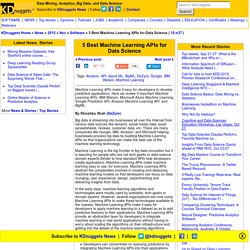
Here we review 5 important Machine Learning APIs: IBM Watson, Microsoft Azure Machine Learning, Google Prediction API, Amazon Machine Learning API, and BigML. By Khushbu Shah (DeZyre). Big data is streaming into businesses all over the Internet from various data sources like sensors, social media data, excel spreadsheets, reviews, customer data, etc.
There are many companies like Google, IBM, Amazon, and Microsoft helping businesses process big data by building Machine Learning APIs so that organizations can make the best use of the machine learning technology. Machine learning courses online. How do you learn machine learning?
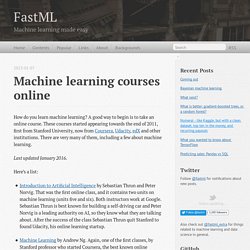
A good way to begin is to take an online course. These courses started appearing towards the end of 2011, first from Stanford University, now from Coursera, Udacity, edX and other institutions. There are very many of them, including a few about machine learning. Last updated January 2016. Here’s a list: Introduction to Artificial Intelligence by Sebastian Thrun and Peter Norvig. Besides these classes, there are many more about statistics, computer vision, natural language processing and whatnot. A revolution in higher education is underway, so take your part. The MOOCs mentioned above feature some degree of interactivity, including homework and forums. 1. Input — R Tutorial. Here we explore how to define a data set in an R session.
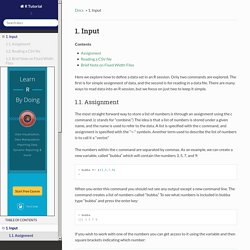
Only two commands are explored. The first is for simple assignment of data, and the second is for reading in a data file. There are many ways to read data into an R session, but we focus on just two to keep it simple. 1.1. Assignment¶ The most straight forward way to store a list of numbers is through an assignment using the c command. The numbers within the c command are separated by commas. When you enter this command you should not see any output except a new command line. If you wish to work with one of the numbers you can get access to it using the variable and then square brackets indicating which number: > bubba[2][1] 5> bubba[1][1] 3> bubba[0]numeric(0)> bubba[3][1] 7> bubba[4][1] 9 Notice that the first entry is referred to as the number 1 entry, and the zero entry can be used to indicate how the computer will treat the data.
You now have a list of numbers and are ready to explore. Titanic: Getting Started With R. So you’re excited to get into prediction and like the look of Kaggle’s excellent getting started competition, Titanic: Machine Learning from Disaster?
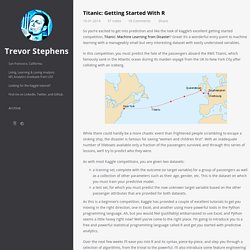
Great! It’s a wonderful entry-point to machine learning with a manageably small but very interesting dataset with easily understood variables. In this competition, you must predict the fate of the passengers aboard the RMS Titanic, which famously sank in the Atlantic ocean during its maiden voyage from the UK to New York City after colliding with an iceberg. While there could hardly be a more chaotic event than frightened people scrambling to escape a sinking ship, the disaster is famous for saving “women and children first”. With an inadequate number of lifeboats available only a fraction of the passengers survived, and through this series of lessons, we’ll try to predict who they were. As with most Kaggle competitions, you are given two datasets: I will be dividing this series of tutorials into five parts: